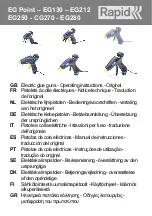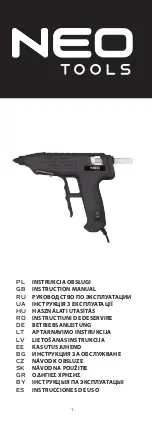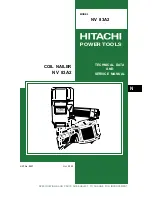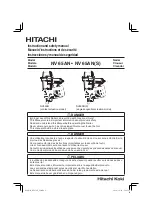
This appliance is not intended for
use by persons (including children) with
reduced physical, sensory or mental capabilities, or lack of experience and
knowledge, unless they have been given supervision or instruction concerning use
of the appliance by a person responsible for their safety. Young children should be
supervised to ensure that they do not play with the appliance.
This tool must be placed on its stand when not in use.
Safety Tips
• Be careful when using the appliance in places where there are combustible
materials;
• Do not apply to the same place for a long time;
• Do not use in the presence of an explosive atmosphere;
• Be aware that heat may be conducted to combustible materials that are out of
sight;
• Place the appliance on its stand after use and allow it to cool down before storage;
• Do not leave the appliance unattended when it is switched on.
• Do not touch hot glue.
• Do not leave glue gun unattended while in use or directly after use.
• Do not touch the nozzle end of the gun while in use or directly after use.
• Do not inhale vapours generated while in use.
•
Do not attempt to feed any other materials through the glue gun, eg. crayons,
sealants, candles etc.
Recommendations for the use of a residual current device
with a rated residual
current of 30mA or less.
Ensure the area is well ventilated.
GLUE GUN SAFETY INSTRUCTIONS
The electric motor has been designed for 230V and 240V only. Always check that the power supply
corresponds to the voltage on the rating plate.
Note: The supply of 230V and 240V on Ozito tools are interchangeable for Australia and New Zealand.
This tool is double insulated; therefore no earth wire is required.
If the supply cord is damaged, it must be replaced by an electrician
or a power tool repairer in order to avoid a hazard.
Note: Double insulation does not take the place of normal safety precautions when operating this tool. The
insulation system is for added protection against injury resulting from a possible electrical insulation failure
within the tool.
Using an Extension Lead
Always use an approved extension lead suitable for the power input of this tool. Before use, inspect the
extension lead for signs of damage, wear and ageing. Replace the extension lead if damaged or defective.
When using an extension lead on a reel, always unwind the lead completely. Use of an extension lead not
suitable for the power input of the tool or which is damaged or defective may result in a risk of fire and electric
shock.
GENERAL POWER TOOL SAFETY WARNINGS
ELECTRICAL SAFETY
WARNING!
Read all safety warnings and all instructions.
Failure to follow the warnings and
instructions may result in electric shock, fire and/or serious injury.
Save all warnings and instructions for future reference. The term “power tool” in the
warnings refers to your mains-operated (corded) power tool or battery-operated (cordless) power
tool.
1. Work area safety
a.
Keep work area clean and well lit
. Cluttered or dark areas invite accidents.
b.
Donotoperatepowertoolsinexplosiveatmospheres,suchasinthepresenceofflammable
liquids, gases or dust.
Power tools create sparks which may ignite the dust or fumes.
c.
Keep children and bystanders away while operating a power tool.
Distractions can cause you to
lose control.
2. Electrical safety
a.
Power tool plugs must match the outlet. Never modify the plug in any way. Do not use any
adapter plugs with earthed (grounded) power tools.
Unmodified plugs and matching outlets will
reduce risk of electric shock.
b.
Avoid body contact with earthed or grounded surfaces, such as pipes, radiators, ranges and
refrigerators.
There is an increased risk of electric shock if your body is earthed or grounded.
c.
Do not expose power tools to rain or wet conditions.
Water entering a power tool will increase the
risk of electric shock.
d.
Do not abuse the cord. Never use the cord for carrying, pulling or unplugging the power tool.
Keep cord away from heat, oil, sharp edges or moving parts.
Damaged or entangled cords increase
the risk of electric shock.
e.
When operating a power tool outdoors, use an extension cord suitable for outdoor use.
Use of a
cord suitable for outdoor use reduces the risk of electric shock.
3. Personal safety
a.
Stay alert, watch what you are doing and use common sense when operating a power tool. Do
notuseapowertoolwhileyouaretiredorundertheinfluenceofdrugs,alcoholormedication.
A
moment of inattention while operating power tools may result in serious personal injury.
b.
Use personal protective equipment. Always wear eye protection.
Protective equipment such as dust
mask, non-skid safety shoes, hard hat, or hearing protection used for appropriate conditions will reduce
personal injuries.
c.
Preventunintentionalstarting.Ensuretheswitchisintheoff-positionbeforeconnectingto
power source and/or battery pack, picking up or carrying the tool.
Carrying power tools with your
finger on the switch or energising power tools that have the switch on invites accidents.
d.
Remove any adjusting key or wrench before turning the power tool on.
A wrench or a key left
attached to a rotating part of the power tool may result in personal injury.
e.
Do not overreach. Keep proper footing and balance at all times.
This enables better control of the
power tool in unexpected situations.
f.
Dress properly. Do not wear loose clothing or jewellery. Keep your hair, clothing and gloves away
from moving parts.
Loose clothes, jewellery or long hair can be caught in moving parts.
g.
If devices are provided for the connection of dust extraction and collection facilities, ensure
these are connected and properly used.
Use of dust collection can reduce dust-related hazards.
h.
Do not let familiarity gained from frequent use of tools allow you to become complacent and
ignore tool safety principles.
A careless action can cause severe injury within a fraction of a second.
4. Power tool use and care
a.
Do not force the power tool. Use the correct power tool for your application.
The correct power tool
will do the job better and safer at the rate for which it was designed.
b.
Donotusethepowertooliftheswitchdoesnotturnitonandoff.
Any power tool that cannot be
controlled with the switch is dangerous and must be repaired.
c.
Disconnect the plug from the power source and/or the battery pack from the power tool before
making any adjustments, changing accessories, or storing power tools.
Such preventive safety
measures reduce the risk of starting the power tool accidentally.
d.
Store idle power tools out of the reach of children and do not allow persons unfamiliar with the
power tool or these instructions to operate the power tool.
Power tools are dangerous in the hands
of untrained users.
e.
Maintain power tools. Check for misalignment or binding of moving parts, breakage of parts and
anyotherconditionthatmayaffectthepowertool’soperation.Ifdamaged,havethepowertool
repaired before use.
Many accidents are caused by poorly maintained power tools.
f.
Keep cutting tools sharp and clean.
Properly maintained cutting tools with sharp cutting edges are
less likely to bind and are easier to control.
g.
Use the power tool, accessories and tool bits etc. in accordance with these instructions, taking
into account the working conditions and the work to be performed.
Use of the power tool for
operations different from those intended could result in a hazardous situation.
h.
Keep handles and grasping surfaces dry, clean and free from oil and grease.
Slippery handles and
grasping surfaces do not allow for safe handling and control of the tool in unexpected situations.
5. Service
a.
Haveyourpowertoolservicedbyaqualifiedrepairpersonusingonlyidenticalreplacement
parts.
This will ensure that the safety of the power tool is maintained.
























